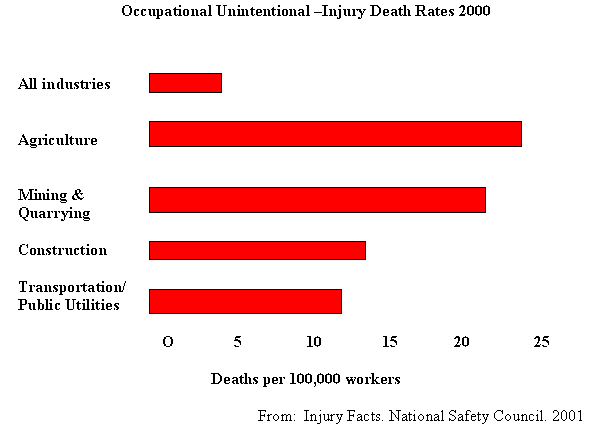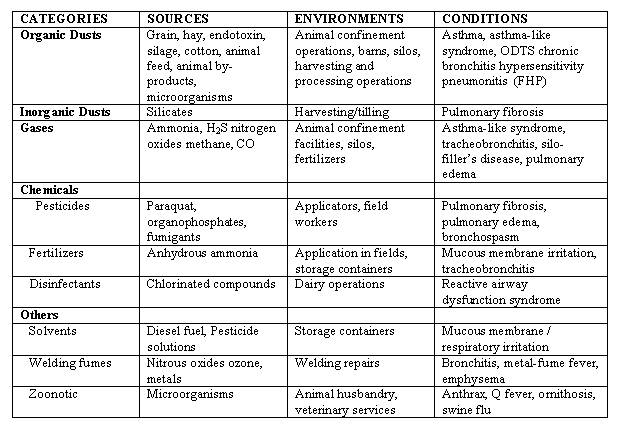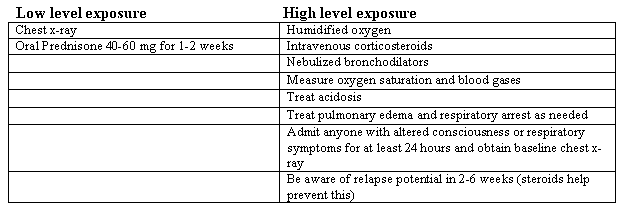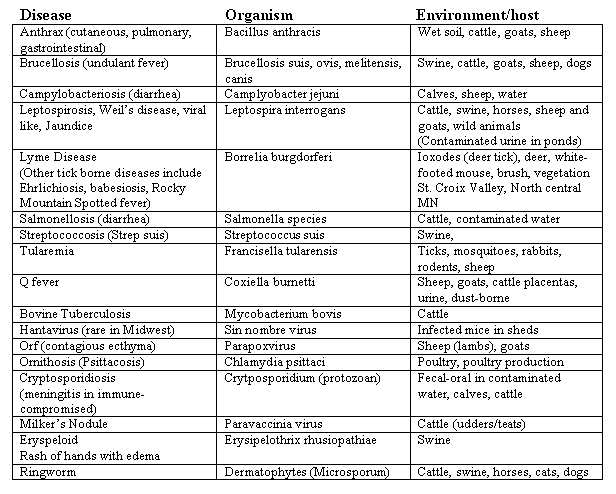Occupational Health Hazards
Physical forces/injuries from machinery and animals
Ergonomic issues - repetitive stress
Electrical
Noise
Organic and inorganic dusts
Agricultural chemicals such as solvents, disinfectants and pesticides
Toxic gases
Infectious microorganisms
Environmental - cold, heat, solar, and floods
Psychological
Illnesses and Injuries
Injuries – Fatal
- Non-fatal-amputations, crush, lacerations, fractures, burns, back pain
and arthritis
Respiratory disease
Asthma
Farmer’s Hypersensitivity Pneumonitis (FHP)
Organic Dust Toxic Syndrome (ODTS)
Bronchitis
Hearing Loss
Cancer
Pesticide-related illnesses
Zoonoses
Dermatitis
Mental health conditions
Child Labor Act Issues
Children must be over 14 and have a certificate of training to handle farm-type
tractors and self-propelled vehicles unless 17 years old and a high school graduate.
Hazardous operations for children under 16
o Operating tractors over 20 PTO horsepower
o Connecting/disconnecting equipment to tractors as above
o Operating corn picker, grain combine, haymower, auger conveyor
o Working inside grain storage with oxygen deficiency
o Handling agricultural chemicals (e.g. pesticides)
o Transporting anhydrous ammonia

Agricultural Respiratory Hazards and Diseases

Occupational History
As developed by the Agromedicine Program of the Medical University of South Carolina
Brief initial history: WHACS
W-what do you do
H-how do you do it
A-are you concerned about your exposures
C-are co-workers (family members) concerned or have similar symptoms
S-are you satisfied with your job (environment)
A more complete history can involve:
o a more detailed occupational and environmental history including a chronological listing of
occupations, work practices, and use of personal protection devices
o agricultural chemical and pesticide use, crops and animals produced
o looking at material safety data sheets (MSDS)
o medical literature search.
Differentiation of ODTS vs. acute FHP

Toxicologic Properties and Health Effects of Hydrogen Sulfide (H2S)
o Chemical asphyxiant with effects very similar to cyanide
o Heavier than air
o Rotten egg smell at very low levels, paralysis of olfactory nerve at higher levels with loss of smell,
(cannot depend upon rotten egg smell to determine if safe levels because of low odor threshold)
Respiratory and mucous membrane irritant at low levels
o Very toxic at higher levels when manure is agitated during emptying pits and can cause rapid loss
of consciousness, pulmonary edema, permanent neurologic damage, and death.
o Dust masks or chemical cartridges not adequate protection
Toxicologic Properties and Health Effects of Ammonia
o Lighter than air
o Pungent mucous membrane and respiratory irritant
o Penetrates deeper into lungs by adsorbing on dust and causes pulmonary inflammation
o Leads to chronic sinus symptoms (non-allergic mucous membrane
inflammation syndrome) and chronic bronchitis
o 2-strap dust/mist respirator and goggles adequate protection
Treatment of Silo Gas Exposures

Treatment of anhydrous ammonia exposure
o Always carry a 6-8 ounce squeeze bottle of water when working around anhydrous
o Keep 5 gallons of clean water in a container on the transport or application equipment.
o Flush the eyes in the field immediately with water for 15 minutes before
coming to the medical facility unless it is close by.
o Flush for at least 15 minutes with cool or luke-warm water in the Emergency
Department with IV tubing, eye cups, topical anesthetic.
o Obtain an Ophthamology consultation.
Selected Zoonotic Diseases found in Agriculture in the Midwest

Manifestations of Anthrax
1. Cutaneous
a. Most common naturally occurring form
b. Treated by antibiotics-20% fatal if not treated
c. Progresses from papule to painless depressed black eschar
d. From contact with infected animal, infected carcasses in rendering plants
2. Gastrointestinal
a. From eating contaminated meat
b. Gastroenteritis with vomiting and bloody stools
c. Mortality 25-75% without treatment
3. Inhalational-most likely form due to bioterrorism
a. Most severe, 100% fatality if not treated
b. Mild nonspecific initial symptoms
c. Later (3-5 days) rapid progression to severe respiratory distress
d. Most fatal in young and elderly
e. Early suspicion and antibiotic treatment can prevent death
Pathophysiology of organophosphate/carbamate poisoning
o Organophosphates cause an irreversible binding of acetylcholinesterase (enzyme that breaks down
acetylcholine at nerve synapses) leading to acetylcholine excess.
o Decreases plasma and red blood cell cholinesterase levels
o Carbamates lead to a reversible binding of acetylcholinesterase
o Muscarinic (cholinergic effects)-bradycardia, salivating, sweating, blurred vision
o Nicotinic effects-muscle twitching, tachycardia, paralysis
o Central nervous system effects-anxiety, personality changes, psychosis convulsions
Treatment of Organophosphate (OP) poisoning
o Atropine given in large (massive) doses to reverse muscarinic effects in severe
poisonings for both OP and carbamate poisoning
o In life-threatening cases, oximes (2-PAM or praloxidime) is given within 72
hours for organophosphate poisoning only to prevent irreversible
binding of acetylcholinesterase
o Treat seizures with appropriate anti-convulsants (diazepam)
o Provide adequate oxygenation with oxygen, bronchodilators
o Consult with Poison Center
Diagnois of Organophosphate poisoning
o Pattern of muscarinic, nicotinic, and CNS symptoms
o History of working in fields, agricultural worker, pesticide applicator
o Consider intentional poisoning in adult or accidental in child
o Draw baseline red blood cell and plasma cholinesterase before starting treatment but do not delay
treatment while waiting for results. (after the fact diagnosis only)
o Redraw cholinesterases in several days and follow for 1-3 months




